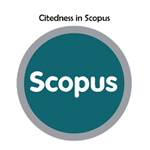Effectiveness of Anticoagulants in Reducing D-Dimer Levels in COVID-19 Patients: A Retrospective Study
Abstract
Coronavirus Disease 2019 (COVID-19) is an acute respiratory infection caused by the SARS-CoV-2 virus. SARS-CoV-2 infection is often associated with blood clotting disorders, both at the microvascular and macrovascular levels due to hypercoagulability. Changes in blood clotting status are indicated by high levels of D-dimer and fibrinogen. The study aimed to evaluate the effectiveness of three anticoagulant therapies in reducing D-dimer levels in COVID-19 patients. The research employed an observational analytical method with a retrospective cross-sectional study design. The results showed significant differences in D-dimer reduction among the treatment groups. The mean reductions in D-dimer levels for patients receiving anticoagulant therapy with heparin, enoxaparin, and fondaparinux were 1.397 µg/L, 2.607 µg/L, and 2.855 µg/L, respectively. Statistical analysis indicated a significant difference among the groups (P < 0.05). It can be concluded that fondaparinux demonstrated a greater reduction in D-dimer levels compared to heparin and enoxaparin.
Keywords
Full Text:
PDFReferences
J. D. Pierce, Q. Shen, S. A. Cintron, and J. B. Hiebert, "Post-COVID-19 Syndrome" Nurs Res, vol. 71, no. 2, pp. 164-174, Apr. 2022, doi: 10.1097/NNR.0000000000000565.
"covid-19 patogenesis".
"Outcome_Terapi_Covid-19_pada_Pasien_yang_Mendapatk".
M. Y. Abou-Ismail, A. Diamond, S. Kapoor, Y. Arafah, and L. Nayak, "The hypercoagulable state in COVID-19: Incidence, pathophysiology, and management" Oct. 01, 2020, Elsevier Ltd. doi: 10.1016/j.thromres.2020.06.029.
N. Tang, D. Li, X. Wang, and Z. Sun, "Abnormal coagulation parameters are associated with poor prognosis in patients with novel coronavirus pneumonia" Journal of Thrombosis and Haemostasis, vol. 18, no. 4, pp. 844-847, Apr. 2020, doi: 10.1111/jth.14768.
C. Lodigiani et al., "Venous and arterial thromboembolic complications in COVID-19 patients admitted to an academic hospital in Milan, Italy" Thromb Res, vol. 191, pp. 9-14, Jul. 2020, doi: 10.1016/j.thromres.2020.04.024.
P. Iik and B. Wiyata, "ANTICOAGULANT EFFECTIVITY IN COVID-19 PATIENT."
"Outcome_Terapi_Covid-19_pada_Pasien_yang_Mendapatk".
J. Thachil, M. Cushman, and A. Srivastava, "A proposal for staging COVID-19 coagulopathy" Jul. 01, 2020, Blackwell Publishing Ltd. doi: 10.1002/rth2.12372.
N. Anggraeni, "Manajemen Koagulopati pada Pasien Covid-19."
L. K. Moores et al., "Prevention, Diagnosis, and Treatment of VTE in Patients With Coronavirus Disease 2019: CHEST Guideline and Expert Panel Report" Chest, vol. 158, no. 3, pp. 1143-1163, Sep. 2020, doi: 10.1016/j.chest.2020.05.559.
O. Oliynyk et al., "Comparison of the effect of unfractionated heparin and enoxaparin sodium at different doses on the course of covid-19-associated coagulopathy" Life, vol. 11, no. 10, Oct. 2021, doi: 10.3390/life11101032.
T. J. Poterucha, P. Libby, and S. Z. Goldhaber, "More than an anticoagulant: Do heparins have direct anti-inflammatory effects?" Thromb Haemost, vol. 117, no. 3, pp. 437-444, 2017, doi: 10.1160/TH16-08-0620.
R. J. Jose and A. Manuel, "COVID-19 cytokine storm: the interplay between inflammation and coagulation" Jun. 01, 2020, Lancet Publishing Group. doi: 10.1016/S2213-2600(20)30216-2.
"COVID-19 Treatment Guidelines 2."
"jfab042".
M. Z. Yan, M. Yang, and C. L. Lai, "Post-COVID-19 Syndrome Comprehensive Assessment: From Clinical Diagnosis to Imaging and Biochemical-Guided Diagnosis and Management" Feb. 01, 2023, MDPI. doi: 10.3390/v15020533.
B. Hidup, D. Tidak Bertahan, and H. Yang, "The Comperative of Coagulation Profile Surviving And Non Surviving Covid-19 Patients That Get An Anticoagulan Theraphy in ICU."
J. E. Gómez-Mesa, S. Galindo-Coral, M. C. Montes, and A. J. Muñoz Martin, "Thrombosis and Coagulopathy in COVID-19" Mar. 01, 2021, Mosby Inc. doi: 10.1016/j.cpcardiol.2020.100742.
A. C. Spyropoulos et al., "Scientific and Standardization Committee communication: Clinical guidance on the diagnosis, prevention, and treatment of venous thromboembolism in hospitalized patients with COVID-19" Journal of Thrombosis and Haemostasis, vol. 18, no. 8, pp. 1859-1865, Aug. 2020, doi: 10.1111/jth.14929.
B. Bikdeli et al., "COVID-19 and Thrombotic or Thromboembolic Disease: Implications for Prevention, Antithrombotic Therapy, and Follow-Up: JACC State-of-the-Art Review" Jun. 16, 2020, Elsevier USA. doi: 10.1016/j.jacc.2020.04.031.
R. Suhartono and N. T. Nugroho, "Dealing with Hypercoagulability Problem in COVID-19 Cases" Journal of Indonesian Society for Vascular and Endovascular Surgery, vol. 2, no. 1, pp. vi-vii, Jan. 2021, doi: 10.36864/jinasvs.2021.1.001.
S. Cui, S. Chen, X. Li, S. Liu, and F. Wang, "Prevalence of venous thromboembolism in patients with severe novel coronavirus pneumonia" Journal of Thrombosis and Haemostasis, vol. 18, no. 6, pp. 1421-1424, Jun. 2020, doi: 10.1111/jth.14830.
A. Kollias, K. G. Kyriakoulis, E. Dimakakos, G. Poulakou, G. S. Stergiou, and K. Syrigos, "Thromboembolic risk and anticoagulant therapy in COVID-19 patients: emerging evidence and call for action" Jun. 01, 2020, Blackwell Publishing Ltd. doi: 10.1111/bjh.16727.
M. Z. Yan, M. Yang, and C. L. Lai, "Post-COVID-19 Syndrome Comprehensive Assessment: From Clinical Diagnosis to Imaging and Biochemical-Guided Diagnosis and Management" Feb. 01, 2023, MDPI. doi: 10.3390/v15020533.
DOI: https://doi.org/10.37311/ijpe.v5i1.30233
Refbacks
- There are currently no refbacks.
Copyright (c) 2025 Lelly Winduhani Astuti

Indonesian Journal of Pharmaceutical Education is licensed under a Creative Commons Attribution-NonCommercial-ShareAlike 4.0 International License.




